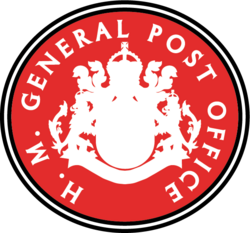Nortish Post
| His Majesty’s Board of Mails | |||||||
|---|---|---|---|---|---|---|---|
 | |||||||
| Formed | 18th century | ||||||
| Jurisdiction | Great Nortend | ||||||
| Headquarters | General Post Office, Edcheap, Lendert | ||||||
| Master of Mails | James Kinson | ||||||
| Secretary | Sir Michael Smith | ||||||
| Part of a series on the Government of Great Nortend | |||||||
| The Crown | Alexander II | ||||||
| |||||||
His Majesty's Board of Mails is the public postal, telegraph, telephone and wireless communications authority in Great Nortend. It was formed in the 18th century when the Royal Mails, a department of the Royal Household headed by the Master of the Mails, began offering services to the general public. It was a founding member of the Astyrian Postal League. The Board is based at the General Post Office in Lendert-with-Cadell, on the Edcheap.
History
The system of Royal Mails operated a network of mail coaches driving between post houses carrying official correspondence. The Master of the Mails, an officer of the Chancery, was in charge of the delivery of the Mails and the maintance of the network of posts. Private correspondence was unofficially accepted by the Master of the Mails until the 18th century, when Queen Mary formally approved the carriage of „Common Mails” for fees.
With the introduction of the railways carrying mails and parcels, the official mail coach network was threatened, as monopolies had only been granted to local postmasters to deliver common letters locally, not to the carriage of mails. Furthermore, the prepayment of carriage used by the railways was attractive to both senders and receivers, compred to the traditional practice of the recipient paying for the letter.
The state postal service faced with this competition, the Postal Services Act reformed the department of the Royal Mails, headed by the Master of Mails, forming the Board of Mails. The Board was responsible for keeping posthouses and for accepting mails and delivering letters, facilitated by introduction of the postage stamp in 1883. The Master of the Mails was still required to keep all of the Royal Mails under guard when in carrige; however, in practice this simply meant appointing officers of the Board of Mails, i.e. postmen, as mail guards. In 1901, most railway guards also began to receive the Master of the Mails' warrant, enabling the railways to carry official Royal Mails for the first time. International airmail is carried aboard Royal Airways airliners.
Addresses
The Nortish addressing system is a admixture of a numbering system with the more traditional building naming system. Generally, buildings are numbered either consecutively along a street or in the „European” system, with odd on one side and even on the other. Many homes have registered or commonly used names which may be used instead of numbers. Thus, the address „5 Church Street, Popford, Eamshire 272” is more commonly addressed „Smithavalon House, Popford, Eamshire 272”.
Posting Codes
The Board of Mails administers the system of “Posting Codes” which are used for the efficient sorting and delivery of mail. The system allocates a two digit “Region Number” number to each postal region within a postal county. Local districts are allocated a number known as the “District Number” which affixed to the Region Number, forms the Posting Code. The District Number is placed after the postal county in addresses.
For example, the postal county of Eamshire is split up into thirteen postal regions. The Asham postal region is given the Region Number 27. The Asham district, which covers the town of Asham itself, has District Number 1 whilst the Popford district has District Number 2. The Grant's Cross area, which within the Popford district, has the Area Number 2. This is written with the postal county, District Number and Region Number as Eamshire 2722.
It is not necessary to a use all digits of a Posting Code. A letter to Grant's Cross may simply be addressed Eams. 272 or even Ea. 27. It is even not necessary to use the Posting Code at all, although a full address with locality and county must always be provided. Providing a full Posting Code may assist in the quicker delivery of mail.
Posting Codes are also used in the Telegraphic Numbering Plan used for telephone and telegraph numbers. In such usage, the two letter abbreviation of the county, the Region Number and the District Number make up the five digit region number.
This page is written in Erbonian English, which has its own spelling conventions (colour, travelled, centre, realise, instal, sobre, shew, artefact), and some terms that are used in it may be different or absent from other varieties of English. |
